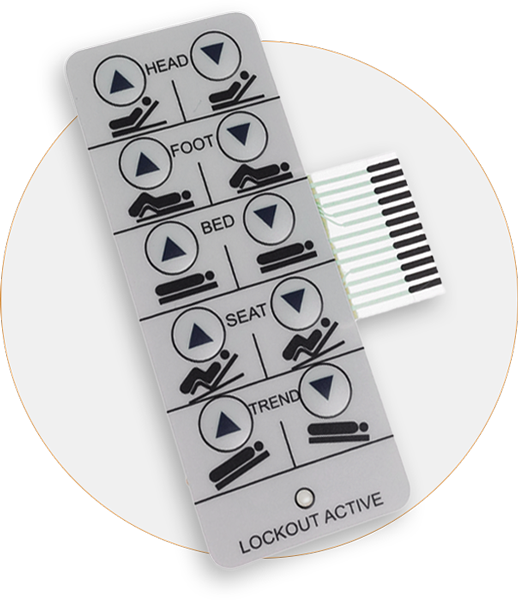The Full Overview to Membrane Switch Innovation and Its Applications
The Full Overview to Membrane Switch Innovation and Its Applications
Blog Article
The Role of Membrane Layer Switches Over in Enhancing Tool Usability and Visual Appeal
Membrane changes represent a considerable advancement in interface modern technology, perfectly integrating usability with visual appeal. Their style is not only practical, using responsive controls in a portable form, however likewise personalized, permitting for special branding and visual interaction. As markets significantly prioritize customer experience, the ramifications of these features extend beyond plain benefit, affecting product design and customer fulfillment. What stays to be checked out is just how these components will progress in action to arising trends and technical improvements, shaping the future of human-device communication.
Understanding Membrane Layer Change Technology

The visuals overlay functions as the noticeable surface area, often published with icons and tags that guide individual communication. Beneath this layer, the spacer works as a separator, guaranteeing that the conductive layer only makes contact when a switch is pushed. The conductive layer, usually made from a conductive ink or product, finishes the circuit and sends signals to the tool's electronic devices.
Sturdiness is a significant advantage of membrane layer switches, as they are resistant to dampness, dirt, and impurities, making them ideal for various settings. Additionally, membrane switches can be tailored in terms of form, size, and layout, allowing makers to customize interfaces to details tool requirements. This convenience adds to their extensive usage across markets, from customer electronic devices to clinical gadgets.
Usability Advantages of Membrane Buttons
The usability advantages of membrane buttons appear in their user-friendly layout and straightforward features. These buttons help with simple interaction by including tactile responses and well-known icons, which enhance the user experience via clear communication of feature (Membrane Switch). The level profile of membrane layer changes enables simple integration into different tools, reducing the discovering contour for customers not familiar with complicated controls
Additionally, membrane layer switches are often created with sensitivity in mind, enabling users to involve with controls easily. This particular is especially beneficial in atmospheres where fast responses are essential, such as medical devices and industrial machinery. Their resistance to dampness and impurities better ensures reliable procedure, promoting customer confidence in diverse settings.
Moreover, membrane layer buttons can be tailored to suit particular applications, fitting one-of-a-kind individual needs and choices. This flexibility fosters a feeling of possession amongst customers, as they can connect with controls that feel tailored to their demands.
Aesthetic Enhancements With Design
Aesthetic enhancements play a substantial role in the general charm and capability of devices outfitted with membrane layer buttons. These buttons use functional layout possibilities that can be tailored to fulfill brand identification and user choices. The ability to incorporate dynamic colors, personalized graphics, and differed textures allows producers to create aesthetically striking user interfaces that resonate with individuals on a psychological degree.
The adaptability of membrane button layout likewise promotes the integration of special shapes and formats, adding to a structured look that improves the user experience. This not only makes tools much more eye-catching but also why not try here aids in intuitive navigation, as users can conveniently identify functional locations and controls. Additionally, advanced printing modern technologies enable the reproduction of detailed layouts and high-resolution pictures, further elevating the aesthetic high quality.
Moreover, the usage of backlighting in membrane layer switches can significantly boost visibility and charm, especially in low-light settings. This mix of aesthetic appeals and functionality cultivates an engaging customer experience, making tools not only extra satisfying to make use of but additionally more aligned with contemporary design patterns. Eventually, visual improvements via cautious membrane switch layout can change common gadgets right into engaging, easy to use products.
Applications in Various Industries
In various industries, membrane layer switches have actually ended up being essential parts that boost functionality and functionality across a variety of gadgets. These innovative buttons locate applications in industries such as health care, customer electronics, auto, and industrial devices.
In the healthcare sector, membrane switches are commonly utilized in clinical gadgets, such as diagnostic devices and client surveillance systems, where they give user-friendly interfaces that improve customer interaction while keeping hygiene. In consumer electronics, membrane switches facilitate straightforward controls in devices, remote controls, and gaming tools, using seamless operation and visual charm.

Future Patterns in Membrane Layer Buttons
Arising fads in membrane buttons are readied to transform user interfaces across numerous applications, driven by developments in technology and raising customer needs for functionality and style. One significant pattern is the incorporation of capacitive touch modern technology, which supplies a much more receptive and modern-day user experience contrasted to traditional mechanical buttons (Membrane Switch). This change not only enhances use however also enables sleeker gadget looks
Additionally, the integration of personalized graphics and backlighting is ending up being progressively popular. Manufacturers are leveraging innovative printing methods and LED technology to develop visually interesting interfaces that accommodate certain customer requires while enhancing gadget exposure in numerous illumination conditions. This modification cultivates a stronger psychological connection between individuals and their gadgets.

Conclusion
In final thought, membrane switches over dramatically improve both use and visual appeals in modern gadgets. helpful resources Their intuitive style, responsive controls, and adjustable graphics help with user interaction, specifically in vibrant environments. The unification of vivid shades and backlighting not just boosts visual allure however also boosts functionality, permitting for efficient navigation in different lighting problems. As markets remain to develop, the versatility and cutting-edge capacity of membrane layer buttons will likely play a progressively essential function in device style and individual experience.
Report this page